By Jeffrey A. Rendall, Photos by Jeffrey A. Rendall
MIDDLETOWN, MD -- Most people, when faced with a competitive situation, respond in one of two ways -- they wilt, or they prosper (and if you remember this year's Masters, it's mostly wilt).
It may seem unfair, but there's little middle ground when you're talking about the difference between success and failure. A lot depends on preparation for the competition -- and a big part of that is setting goals. Knowing your destination in advance won't guarantee a bump-free journey, but the thoughts of what you'd like to accomplish will often see you through some trying times.
That's exactly what they're doing at Hollow Creek Golf Club in Middletown, Maryland, just a few miles west of Frederick off of Interstate 70. The club's pretty new in a temporal sense, but that doesn't mean they don't know where they want to be a few years down the road.
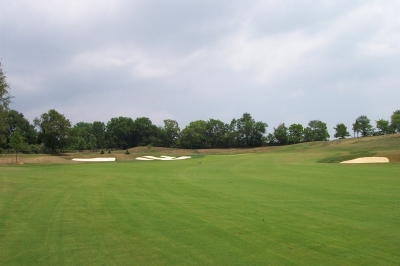 |
| The uphill par five 2nd hole will surrender birdie tries. It's wide, short and reachable. |
Leighton Thomas, Hollow Creek's Head Golf Professional, explains how it is the folks behind the facility know where they're going: "We've always had a pretty good idea of what we wanted from this land and from the community. From the original owners, down to the developer (Natelli Communities), to our owner Steve Kline -- everyone wanted a distinctive type of golf course and community, where players could come to the golf course and avail themselves of private club amenities at a very reasonable price. For that reason, it's our goal to have Hollow Creek go completely private by 2005."
That seems to be a trend these days with semi-private facilities, as we've seen a few go private this year -- such as Stoneleigh Golf Club in Round Hill (west of Leesburg) and Ford's Colony in Williamsburg, to name just a couple.
But the difference between Hollow Creek and many other semi-privates aspiring to go completely private are the amenities already in place. "We wanted to make sure the clubhouse was serviceable when we opened the golf course," remarked Thomas. "Whereas a lot of new courses would open the links and be willing to make do with some temporary facilities, we thought it'd be best to offer more of the completed package up front."
Another way Hollow Creek differs in that regard is its cart path policy -- 90 degrees, despite being open only a few months. That certainly improves pace of play, and will no doubt please potential new members, who otherwise might not be so happy tromping back and forth to the cart on this somewhat hilly layout.
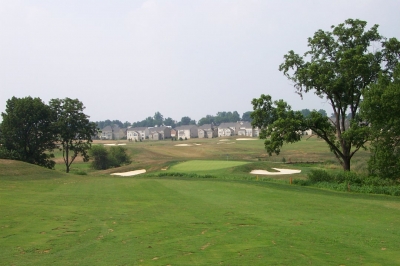 |
| The downhill 446 yard 17th hole will test your shot-making. |
But the hills are vital to giving this course its charm -- and a major asset in Hollow Creek's quest for private club status.
Rick Jacobson, Hollow Creek's course designer, says the beauty and nature of the land combined to make a distinctive golf course: "The Hollow Creek site certainly provides a lot of scenic vistas from the high points of the surrounding terrain. Many of the holes are setup to provide the backdrop of the mountains, so we really tried to maximize the aesthetic qualities of the land. You've got a combination of lowland and upland fields, which provide the scenery."
"Another distinguishing feature is the Hollow Creek corridor that bisects the property, which is integrated into several of the holes. Some holes parallel the corridor, some play over it. The creek provided a variety of ways to assimilate that feature into the plan of the golf course," Jacobson said.
The creek certainly is a prominent feature on the layout, as it influences play on seven holes. Almost all the rest have some sort of elevation change involved, and we still haven't reached Hollow Creek's biggest line of defense: its greens.
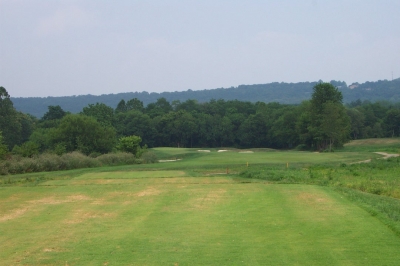 |
| From the tee box on number 13, you'll see there isn't much room to miss. |
Measuring only 6610 yards from the back tees (slope of 134), length is rarely an issue on this course. Thomas puts it succinctly: "Our course isn't as long as most new courses, but it's still well protected. Starting with the greens, which will roll faster than most people are used to (because of the G2 bentgrass), and are pretty sloping and difficult to master. The pin placements are also well guarded with bunkers or hazards. Then there's always the out-of-bounds areas on the course."
Thomas continues, "When you're talking about parameters of play, it's a good compromise between the weaker players and the stronger players. If you don't hit the ball that far, you'll find it's pretty friendly from the front sets of tees. If you're a good player, you might shoot lower if you have a good day than you might expect, but at the same time, if you have a poor ball striking day, your upper parameter's going to be even higher."
That's a very accurate assessment, because this target-oriented layout, from the back tees, requires supreme accuracy on many shots. Case in point is hole thirteen, a par four which only plays to 348 yards but offers a landing area flanked by the creek on the left and wetlands on the right. Don't even think about hitting driver here.
Jacobson says the nature of Hollow Creek's site accounts for its tightness off the tee and somewhat severe greens: "The nature of the terrain and the community master plan pretty much dictated the length of the golf course. Because of it, we provided some areas where you can't necessarily step up on every hole and just grip n' rip your driver. It adds some placement elements to the golf game, where you'll have to manage your way around based on where some of the pin placements are on the greens."
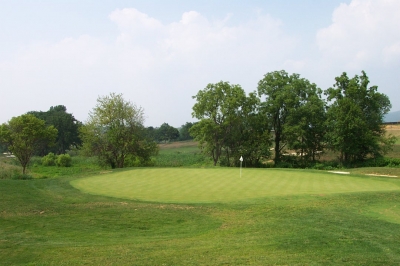 |
| The view of the 16th green presents a pleasant scene. |
"The greens have a little more movement in them than you're probably used to seeing at a public facility. That was one of the elements we introduced to overcome some of the lack of length. It makes it a little bit more of a finesse game," Jacobson added.
In other words, the elements are in place for Hollow Creek's conversion to a private club in the near future. And Thomas says the resources are there for course conditioning, too. "Unfortunately, we've opened during a summer that's been pretty hot and dry, which has made our grow-in more difficult than we anticipated. But our owner is dedicated to making sure the course, once it reaches maturity, will get the money it needs to stay in top form."
"It doesn't matter how many dollar bills you throw at a facility, you can't make grass grow any faster. We've already brought in tractor-trailer loads of sod in the areas where seeding just wouldn't take -- and that's despite some real rough terrain in spots with some significant square footage. We were still willing to do that," Thomas said.
The course is in somewhat rough shape, especially in the closing six or seven holes, which Thomas said were seeded after the others and ran into some weather and terrain problems last fall. But as is the case with any new course, conditioning problems are only temporary. You have to think with the attention that's been paid to the balance of the property, that healthy grass will follow in the not-so-distant future.
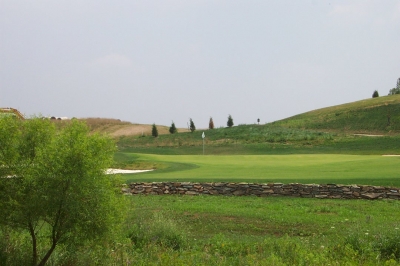 |
| Concentrate on the pin placement when you look at the 4th green -- and make sure you reach the right level. |
Looking at the highlights, number four is an excellent and beautiful par three. 171 yards long, you're called to carry an environmental area, stone wall and deep bunkers to reach a tiered green. If you're on the wrong level, it'll make a two-putt very challenging.
Another good example of a tough green is number seven. The hole is an uphill, 371 yard par four -- it won't kill you with length, but again, it's a short game challenge -- especially if the pin's in front. Talking from experience, if you're on either side of the pin, your first putt may very well roll off the green if you don't hit the hole dead center.
Nine's a beautiful hole. 426 yards and downhill, you can probably club down off the tee and leave it short of the creek bed. The second shot's also downhill, and plays shorter than it looks.
On the backside, a particular favorite was the twelfth hole, another short par four at 356 yards in length. Simply put, the left side of this hole is death from tee to green--hookers beware! Aim for the middle bunker off the tee and let fly, and you'll only have a short iron left for the challenging second shot.
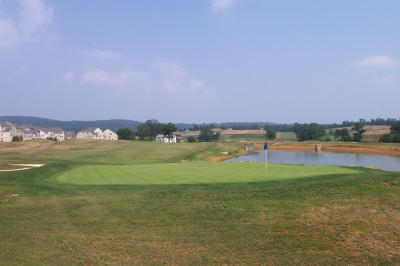 |
| Looking back from behind the 18th green. A fine finishing hole. |
Eighteen, once the course grows in, will be a great finishing hole. Bring the wood on the drive -- and at 438 yards, you'll need it. Bunkers squeeze the tee shot landing area, but there's still ample room. A lake on the left and a large bunker to the right guards the green. The clubhouse provides the backdrop, and your approach will entertain the on-lookers on the deck.
Looking at Hollow Creek in its entirety, you have to think it will make a nice, affordable, family friendly private club one day. That's their goal, and they'll certainly make it. They've got a 'private' type course, friendly service, and a clubhouse conducive to that end. In the meantime, it's worth the effort to try it out while it's open to the public, perhaps even proving that it's great to set goals -- in order to prosper in a competitive situation.
Details:
Hollow Creek Golf Club
Phone: (301) 371-0400
FAX: (301) 371-0300
Website: www.hollowcreekgolfclub.com
Course Designer: Rick Jacobson
Head Golf Professional: Leighton Thomas
Director of Golf: Joe Burden
|
|
Yardage/Slope |
|
Blue |
6610/134 |
|
White |
6411/128 |
|
Green |
5697/120 |
|
Red |
5080/126 |
Rates:
Mon-Thurs: $40 plus tax, includes the golf cart. After 3 p.m., $25 plus tax.
Fri-Sun and Holidays: $60 plus tax. After 3 p.m., $35 plus tax. Includes cart.
For membership information, contact Leighton Thomas at (301) 371-0400 ext. 106.
| Related Links | Comments on this article? | |
|
Maryland National Golf Club Hollow Creek Golf Club Rocky Gap Resort PB Dye Golf Club in Ijamsville Whiskey Creek Golf Club |
E-mail Jeff Rendall, Editor: jrendall@golftheunitedstates.com |











